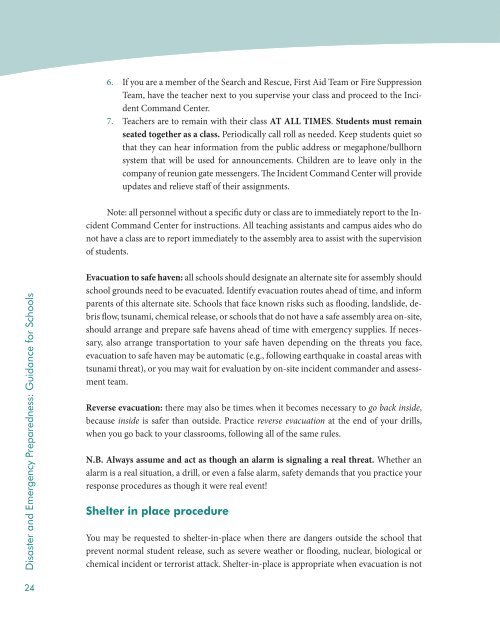Disaster and Emergency Preparedness: Guidance for ... - INEE Toolkit
Disaster and Emergency Preparedness: Guidance for ... - INEE Toolkit
Disaster and Emergency Preparedness: Guidance for ... - INEE Toolkit
You also want an ePaper? Increase the reach of your titles
YUMPU automatically turns print PDFs into web optimized ePapers that Google loves.
6. If you are a member of the Search <strong>and</strong> Rescue, First Aid Team or Fire SuppressionTeam, have the teacher next to you supervise your class <strong>and</strong> proceed to the IncidentComm<strong>and</strong> Center.7. Teachers are to remain with their class AT ALL TIMES. Students must remainseated together as a class. Periodically call roll as needed. Keep students quiet sothat they can hear in<strong>for</strong>mation from the public address or megaphone/bullhornsystem that will be used <strong>for</strong> announcements. Children are to leave only in thecompany of reunion gate messengers. The Incident Comm<strong>and</strong> Center will provideupdates <strong>and</strong> relieve staff of their assignments.Note: all personnel without a specific duty or class are to immediately report to the IncidentComm<strong>and</strong> Center <strong>for</strong> instructions. All teaching assistants <strong>and</strong> campus aides who donot have a class are to report immediately to the assembly area to assist with the supervisionof students.<strong>Disaster</strong> <strong>and</strong> <strong>Emergency</strong> <strong>Preparedness</strong>: <strong>Guidance</strong> <strong>for</strong> SchoolsEvacuation to safe haven: all schools should designate an alternate site <strong>for</strong> assembly shouldschool grounds need to be evacuated. Identify evacuation routes ahead of time, <strong>and</strong> in<strong>for</strong>mparents of this alternate site. Schools that face known risks such as flooding, l<strong>and</strong>slide, debrisflow, tsunami, chemical release, or schools that do not have a safe assembly area on-site,should arrange <strong>and</strong> prepare safe havens ahead of time with emergency supplies. If necessary,also arrange transportation to your safe haven depending on the threats you face,evacuation to safe haven may be automatic (e.g., following earthquake in coastal areas withtsunami threat), or you may wait <strong>for</strong> evaluation by on-site incident comm<strong>and</strong>er <strong>and</strong> assessmentteam.Reverse evacuation: there may also be times when it becomes necessary to go back inside,because inside is safer than outside. Practice reverse evacuation at the end of your drills,when you go back to your classrooms, following all of the same rules.N.B. Always assume <strong>and</strong> act as though an alarm is signaling a real threat. Whether analarm is a real situation, a drill, or even a false alarm, safety dem<strong>and</strong>s that you practice yourresponse procedures as though it were real event!Shelter in place procedureYou may be requested to shelter-in-place when there are dangers outside the school thatprevent normal student release, such as severe weather or flooding, nuclear, biological orchemical incident or terrorist attack. Shelter-in-place is appropriate when evacuation is not24
















